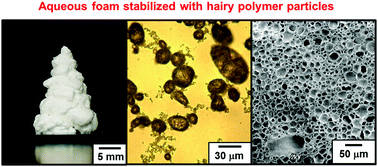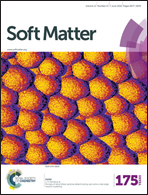Foams stabilized with solid particles carrying stimuli-responsive polymer hairs†
Abstract
Submicrometer-sized polystyrene (PS) particles carrying stimuli-responsive poly[2-(diethylamino)ethyl methacrylate] (PDEA) hairs with degrees of polymerization of 30, 60 and 90 were synthesized by dispersion polymerization and used as a particulate foam stabilizer. The effects of the composition of these PDEA–PS particles and foam formation conditions on foamability, foam stability and foam microstructures were extensively investigated. The hairy particles were found to work as an effective stabilizer of aqueous foams in basic media, in which the PDEA hairs are not protonated and thus the particle surfaces exhibit suitable wettability at the air–water interface. In contrast, little to no foam or unstable foams were formed in acidic aqueous media, in which the hairs are protonated and are therefore water soluble. Particles carrying longer hairs resulted in greater foamability and more highly stabilized foams that were capable of persisting for more than one month. Foams were found to form in a narrower pH range when using PS particles with longer hairs, due to both entropic and image charge effects. Data obtained from the touch mixer mixing method showed that both foamability and foam stability increased with increases in the concentration of polymer particles up to 10 wt%, because higher concentrations allowed greater air–water interfacial areas to be stabilized. Conversely, only minimal foam was obtained at and above 15 wt% because of the high viscosity of the resulting aqueous particle dispersion. Trials using the homogenizer mixing method showed that foam with a cream-like texture could be formed even at 40 wt% particle concentration as a result of the improved mixing efficiency. Defoamation could be induced by exposing the foams to HCl vapor. Exposure to acidic vapor led to in situ protonation of the 2-(diethylamino)ethyl methacrylate residues, rendering the PDEA hairs hydrophilic and water soluble, and desorption of the PDEA–PS particles from the air–water interface.


 Please wait while we load your content...
Please wait while we load your content...